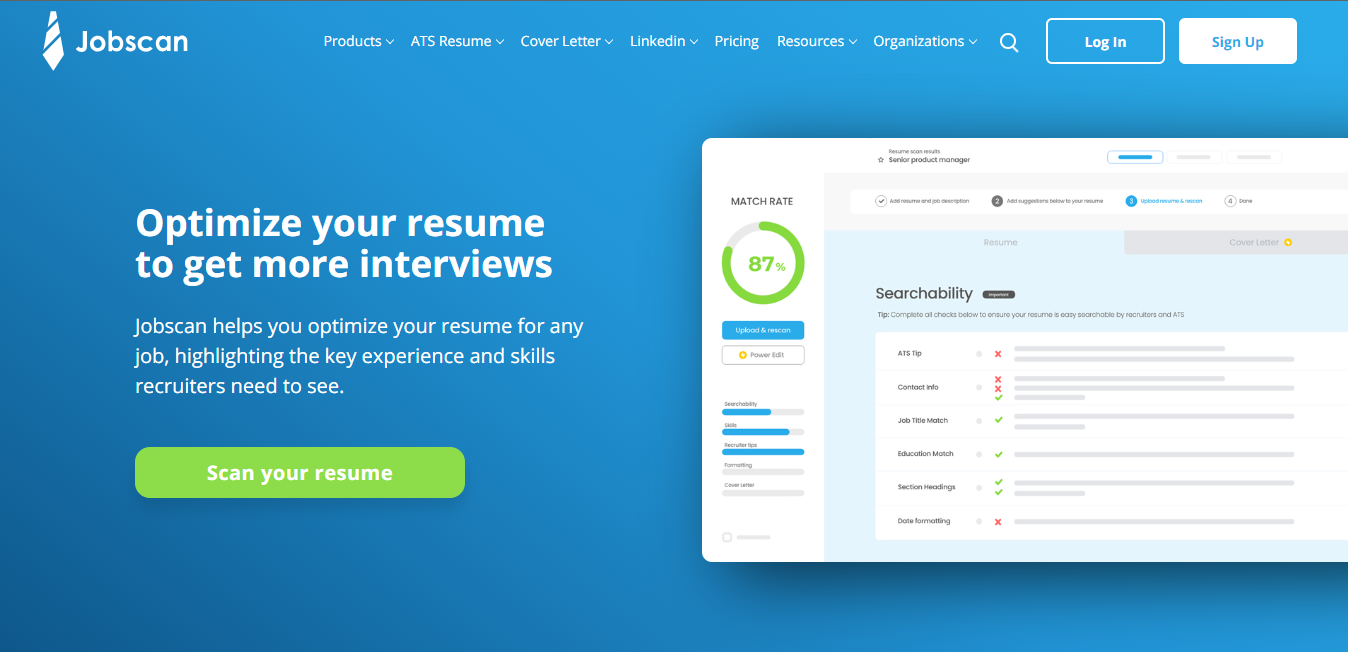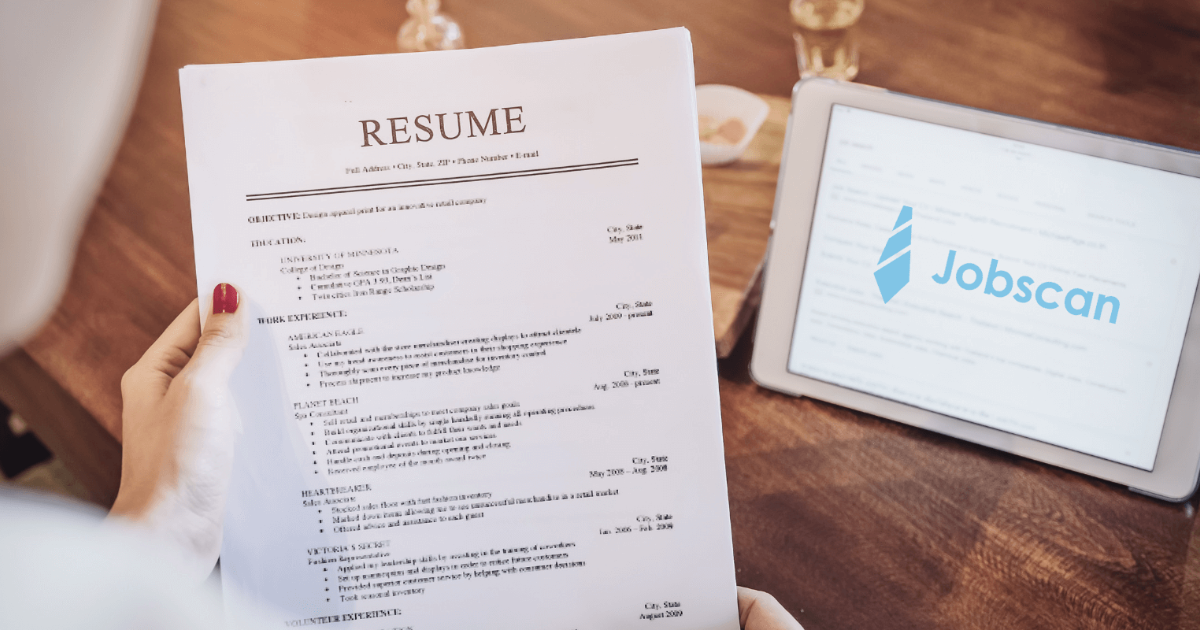-
Price Per Month$49
- Website
Description
Your ultimate job search optimization tool. Scan and optimize your resume, uncovering opportunities to improve match rates and stand out to employers. Boost your chances of landing your dream job with Jobscan's powerful technology. You've mastered the art of a great resume, and you're ready to apply for that job you've been dreaming about. But as much as your resume will get you to the next stage of an interview, it's not always enough.
Free Trial
$ 49
/mo
Jobscan: A Comprehensive Guide to Optimizing Your Job Applications
You've mastered the art of a great resume and are ready to apply for that job you've been dreaming about. But as much as your resume will get you to the next stage of an interview, it's not always enough.

Many factors go into determining whether or not someone is right for a position at a company, and your resume should be one piece of that puzzle. In this guide, we'll teach you how to ensure that everything works in your favor so that when it comes time for an interview—you're ready!
Is your resume the right fit for this job?
When applying for a job, your resume must be tailored to the specific position. It should highlight the skills and experience that are most relevant to the role you're applying for.
If there are certain keywords in the job listing (e.g., "database management" or "project management"), then make sure those words are included on your resume. If no keywords are listed in the description, but buzzwords are used (e.g., "data-driven"), then include those as well--but only if they apply directly to what you've done at previous jobs or school projects!
Your resume should be clear, concise, and easy to read so that hiring managers can quickly scan through it and find what they need quickly without getting bogged down by unnecessary information or formatting issues like font size changes throughout different sections of each document page layout template design flowcharting diagramming flowcharting process diagramming drawing software diagramming drawing toolkit diagramming flowcharting process diagramming drawing software diagramming drawing toolkit
Are you a good cultural fit for the company?
One of the most important factors in deciding whether or not you're a good fit for a company is its culture. The more you learn about that, the better equipped you'll be to show them why they should hire you.

To find out what kind of company culture your potential employer has, look at their website and social media accounts. Are they posting pictures of happy employees working together? Do they have an open-door policy? How often do people get promoted from within? These are all signs that this is a company where employees feel valued and appreciated--and those are qualities worth considering when applying for jobs!
Is there anything else that might disqualify you?
You may be surprised to learn that several things can disqualify you from a job application, even if they're not technically listed on your resume. These include:
- Bad references. Good references should come from former employers, supervisors, or colleagues who have worked closely with you for at least six months. If anyone else gives you a glowing review, it's probably worth taking it with a grain of salt (and maybe checking out their LinkedIn profile).
- Unpaid bills/debt collection notices/bankruptcy filings in the last three years. If this happened recently but was resolved amicably without any issues since then (for example: if someone was laid off and got back on their feet), they might still be able to work around it and give you an opportunity if everything else looks promising enough! But if legal complications like lawsuits or liens were involved...well...you get the idea here too!
Know where to look.
Now that you know how to optimize your resume, let's discuss where to look for jobs. There are a lot of places that you can apply to, and many of them have different requirements.

The first place we recommend looking at is jobscan.com. This site allows users to upload their resumes and get feedback on how they could improve them through an online tool called Resume Assistant. Another great option is LinkedIn; it has millions of members who have posted many jobs on their profiles and can be accessed through desktop computers or mobile devices such as smartphones or tablets (iPads). Glassdoor is another great resource because it allows users who have already secured employment at companies like Apple Inc., Amazon, and Google to share their experiences working there through reviews which often include tips about how best to prepare yourself before applying for any given position within those organizations' ranks!
Don't take anything personally.
The first step in optimizing your job applications is understanding that it's not personal. The people you are applying to work with are trying their best, just like you are. They want to find the right person for the job, and they can only do that by considering many factors--including your qualifications, but also things such as how well-suited your personality is for the workplace culture and whether or not another candidate would be a better fit at this time in their organization's history.
It's critical not only for your mental health but also for getting ahead at work: don't take rejection personally!
A Great Resume Can Help Get You To The Next Stage Of An Interview.
A job offer is your goal, but it's not the only goal. The resume is a tool to help you get there--the same way an application, cover letter, and interviews help companies find candidates they want to hire. Once they make an offer (and if you accept), we've reached our final destination: success!
Conclusion
Jobscan is a great tool that can help you optimize your job applications, but it's not the only one. If you're looking for more resources on this topic, check out our blog post about finding jobs on LinkedIn or our guide on writing effective cover letters.
*Don't leave your job search to chance; let Jobscan lead the way to success.*
Frequently Asked Questions
Is Jobscan free?
Jobscan offers both free and paid plans. The free plan includes five scans per month and basic optimization feedback, while the paid plans offer more scans and advanced features like ATS-specific optimization and keyword analysis.
How does Jobscan work?
To use Jobscan, copy and paste your resume, cover letter, or LinkedIn profile into the tool, along with the job description you're interested in. Jobscan then analyzes your application materials and compares them to the job description, providing a match rate and feedback on improving your documents.
What is Jobscan?
Jobscan is an online tool that helps job seekers optimize their resumes, cover letters, and LinkedIn profiles to increase their chances of getting hired. It uses artificial intelligence to analyze job descriptions and compare them to your application materials, providing feedback on how well your documents match the job requirements.